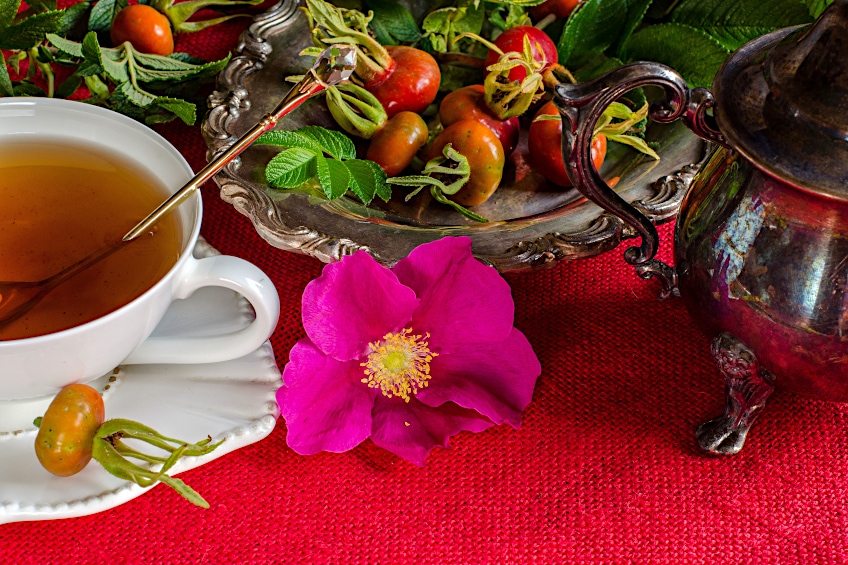How to Make Tea From Rose Hips – Enjoy the Fruits of the Rose
This post may contain affiliate links. We may earn a small commission from purchases made through them, at no additional cost to you.
Are you keen to learn how to make tea from rose hips? Rose hip tea benefits are plentiful, and both fresh and dried rose hip tea is delicious. In this article, we will be discussing how to harvest and prepare rose hips for tea, how to make rose hip tea, as well as rose hips tea recipes to keep you warm and healthy.
Contents
How to Make Tea from Rose Hips
The fruits of wild rose shrubs are known as rose hips. Cultivated roses contain hips as well, however, they are really not the same as wild varieties and are therefore not usable. Wild rose hips are typically red, although there are also orange varieties as well. Late October would be the optimal time to look for them. Rose hips are not ingested like ordinary fruits, despite being classified as such. They are steeped in boiled water to make soothing fresh or dried rose hip tea.

Rose hip plant fruits may be used to produce rose hip marmalade, jam, and skin oil in addition to rose hips tea recipes. Folks can use them both dried and fresh in as many ways due to their health advantages. Many people choose to prepare tea since it yields a wonderfully beneficial hot beverage in the winter. Rosehip tea has a tangy and sweet taste that people enjoy. In the winter it is best drunk hot, while in the summer, drink it cool for a nice refreshing poolside drink.

Rose hips, once widely foraged as a food source, is a good alternative for someone just starting out with foraging. They are easily identified, and women historically taught children how to pick these wild fruits, and even cultivated roses in kitchen gardens for convenient availability. Rose hips are delicious when made into jelly or blended into oils or vinegar.

Rose Hip Tea Benefits
The most widely recognized advantage of rosehip is that it boosts the immune system since it contains 40 times the amount of vitamin C as citrus fruit. As a result, dried rose hip tea is typically served as a natural flu remedy. Its advantages are not confined to this though. Rosehips are also high in antioxidants; therefore, they may be beneficial in the fight against chronic illnesses and even cancer. It is even reported to assist with arthritic pain. Rose hips are also high in vitamins K, E, and B, and they also serve as an antioxidant. Rose hips are therefore perfect to incorporate into herbal treatments and as wintertime foraged sustenance.
Harvesting Your Own Rose Hips
The edible fruit of the rose plant is called rose hips. Although all seed pods are palatable, the wild roses of Atlantic Canada are excellent for foraging. The wild rose hips are often slimmer than the huge circular fruits seen on cultivated versions. Rosa rugosa is native to Siberia and Eastern Asia, where it prefers coastal areas and thrives in sandy environments such as dunes.
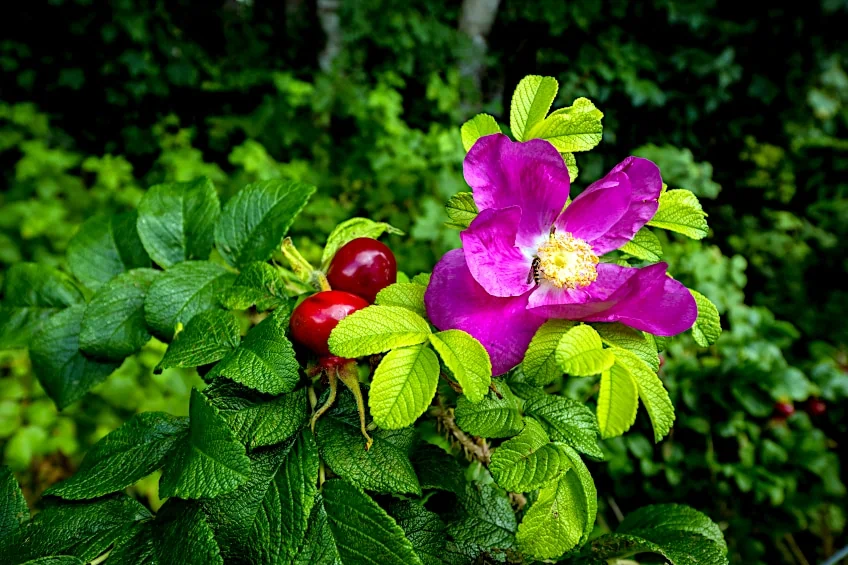
Once the roses have flowered, the rose hip fruits begin to develop in late summer. As a result, if you own a wild rose shrub on your land, avoid deadheading the dead blooms, because if you do, the seed pods will not develop. The optimum time to search for rose hips is after the first frost.
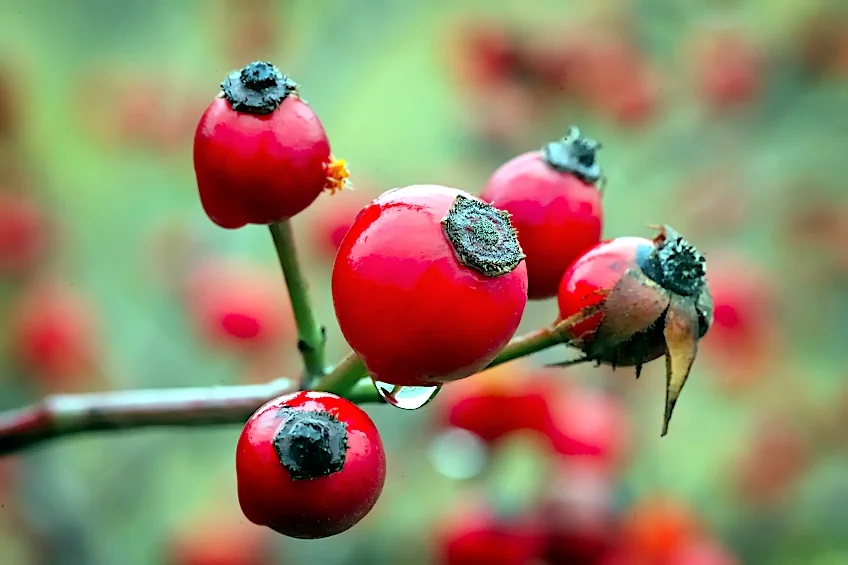
The cold weather boosts the sugar content of the fruit, leaving it sweeter, so don[‘t pick your rosehips too soon. Bring strong gloves when searching for rose hips to prevent being pricked by the countless thorns on these sprawling plants! After the rose hip is hard and completely colored, it may simply be plucked from the stem. Avoid using rose hips that are withered or show indications of bird or insect damage, these can be quite easily noticed as they are generally orange or red in color.
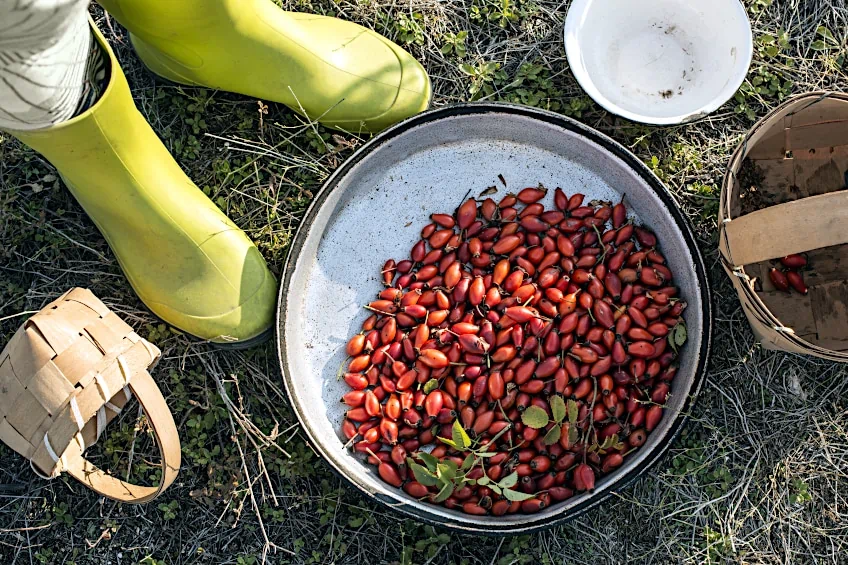
How to Prepare Rose Hips for Tea
Rose hips are best enjoyed fresh to get the most out of the various vitamins included in the fruit. If you want to enjoy delicious iced rosehip tea in summer, then rose hips may also be stored for a long time by drying the fruit and storing it in a dried, dark, and cold place. Rose hips were historically used in teas to treat scurvy and other diseases. Rose plant leaves and roots were also utilized in brews to prevent influenza and colds. After picking the rose hips, rinse them and then either let them dry overnight or rub them gently with a fresh dish towel. If you intend to preserve the rose hips for future use, cut off the bottoms and tops and put these out in the sun to dry thoroughly.
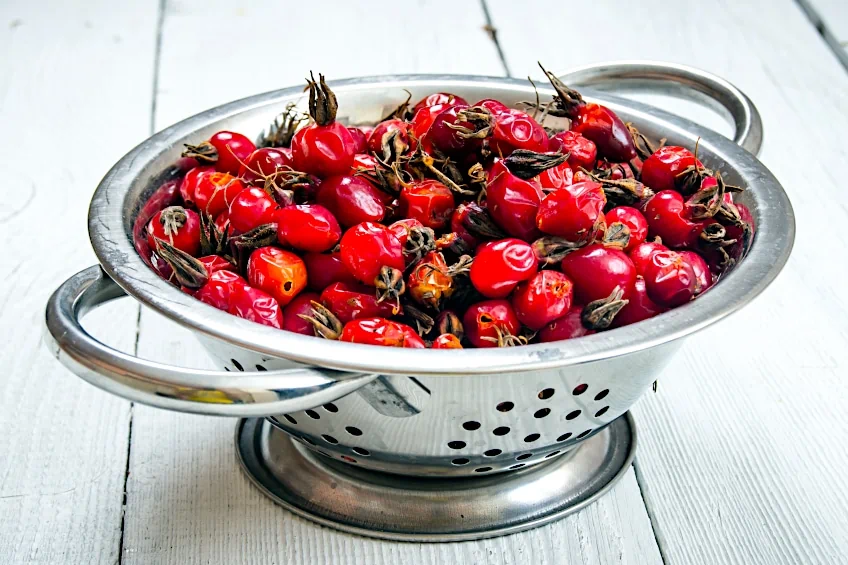
A dehydrator may also be used to accelerate the drying process. No need to concern yourself about all of those tiny seeds at this moment! You may scrape them out if you like, although you might find this part rather time-consuming. Alternatively, you can keep them in. If you’re brewing tea, you’ll already be filtering out the seeds. If you want to make a sauce or use the hips in another dish, first reconstitute the dried hips, then crush and sift the material through a fine mesh screen. If you intend to use the rose hips fresh, just rinse them to eliminate any filth or insects before proceeding with the process. Again, you should use the rose hips intact, then crush and drain the contents through a sieve.
Rose Hips Tea Recipe
So, if you went out foraging for some lovely tiny rose hips and want to brew something convenient and simple, this wild rose hips tea recipe is the option to try. It offers you a good idea of how rose hips taste, and whether going out to harvest more for inclusion in other dishes is worthwhile.
- First, begin by washing and preparing the rose hips as previously instructed.
- Bring a pot of water to a boil, then pour it across the rose hips. If you’re using raw rose hips, combine a quarter cup of rose hips with one cup of water. Use one heaping spoonful of crushed rose hips or each cup of water if you are instead using dried rose hips.
- Leave the tea to simmer for about 15 minutes, covered, before straining out the solids.
As previously mentioned, the tea is high in vitamins, and although the flavor is tangy and strange at first, it gradually grows on you. You can also learn how to make rose hips tea by adding some fresh mint and honey, which is regarded as a winning combination by many. If you want to drink it cool as a summer indulgence, pour everything into a jug, stir in the honey, and refrigerate until cold. Once you know how to make rosehips tea correctly, you could also mix it with a different herbal tea, such as hibiscus, to make your own tea combination. Now you know how to make rose hips tea!
Frequently Asked Questions
When Can I Harvest Rose Hips?
Now that you know how to make tea from rose hips, you would most likely like to know where to source them. Rose hips emerge after the roses have flowered in late summer. The greatest time to go foraging for them is soon after the first frost, when the cold enhances the inherent sugar content, making them tastier. Don’t panic if you pluck them prior to the first frost; the nutritious value will still be there. The wild rose is native to North America. It’s very common from Quebec through Alaska, New Mexico, and the Northern United States. It thrives in open spaces and clearings and also prefers seaside and sandy environments.
How Do You Pick Rose Hips?
Rose bushes, as everyone knows, are prickly. Selecting carefully will save you from being injured by thorns, but heavy leather gloves will make it simpler. When the rose hips become firm and red, just snap the fruit from the end of the branch. Use only the red fruit, and never the green leaves.
How to Prepare Rose Hips for Tea?
When you bring your rose hips home, clean them thoroughly and put them gently on a cloth to dry. Be sure to trim off any leaves or stems that stick out. To make tea with fresh rose hips, combine a quarter cup of fresh rose hips with one cup of water. Boiling water should be poured over the hips. Let the tea to steep for around 20 minutes. The pulp should next be strained out. If necessary, serve with honey.
What Are the Benefits of Rose Hip Tea?
Not only is dried rose hips tea very tasty, but also has several notable health benefits. Wild rose hips’ most well-known benefit is that they enhance the immune system since they contain 40 times the amount of vitamin C as citrus fruit. As a result, dried rose hip tea is commonly used as a natural flu treatment. However, its benefits are not limited to this. Rosehips are also abundant in antioxidants, which may help in the battle against chronic diseases and even cancer. It is even claimed to help with arthritic pain. Rose hips are also strong in vitamins K, E, and B, as well as antioxidants. Rose hips are consequently ideal for use in herbal remedies and as foraged winter food.

